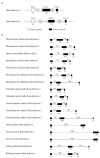Antimicrobial Peptides: Identification of two Beta-Defensins in a Teleost Fish, the European Sea Bass (Dicentrarchus labrax)
- PMID: 34198571
- PMCID: PMC8231796
- DOI: 10.3390/ph14060566
Antimicrobial Peptides: Identification of two Beta-Defensins in a Teleost Fish, the European Sea Bass (Dicentrarchus labrax)
Abstract
Beta-defensins consist in a group of cysteine-rich antimicrobial peptides (AMPs), widely found throughout vertebrate species, including teleost fish, with antimicrobial and immunomodulatory activities. However, although the European sea bass (Dicentrarchus labrax) is one of the most commercially important farmed fish species in the Mediterranean area, the characterization of its beta-defensins and its potential applications are still missing. In this study, we characterized two members of the beta-defensin family in this species. Phylogenetic and synteny analysis places sea bass peptides in the beta-defensin subfamilies 1 and 2, sharing similar features with the other members, including the six cysteines and the tertiary structure, that consists in three antiparallel beta-sheets, with beta-defensin 1 presenting an extra alpha-helix at the N-terminal. Further studies are necessary to uncover the functions of sea bass beta-defensins, particularly their antimicrobial and immunomodulatory properties, in order to develop novel prophylactic or therapeutic compounds to be used in aquaculture production.
Keywords: European sea bass (Dicentrarchus labrax); antimicrobial peptides; aquaculture; beta-defensins.
Conflict of interest statement
The authors declare no conflict of interest. The funders had no role in the design of the study; in the collection, analyses or interpretation of data; in the writing of the manuscript or in the decision to publish the results.
Figures








References
Grants and funding
LinkOut - more resources
Full Text Sources

